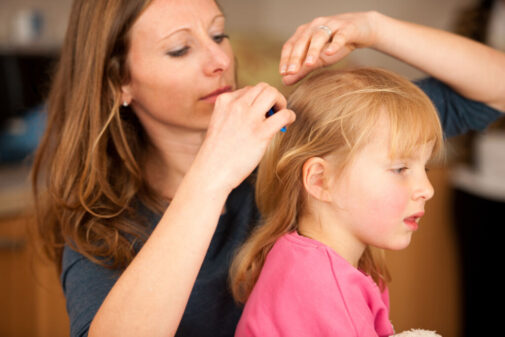Your guide to treating lice

It’s a word no parent wants to hear: lice.
Lice are parasitic insects that feed on human blood and are commonly found on the head and body. They typically are transmitted through direct contact with someone who has them. They don’t jump or fly and can’t be spread through pets or animals, but they can be transmitted through clothing, hats, hairbrushes/combs, bedding and pillows.
“Lice can affect anyone, but they are seen much more frequently in children,” explains Dr. Brian Sapp, a pediatrician with Aurora Health Care. “They are less likely to be found on African American children and affect girls more often than boys, although we aren’t certain why.”
Dr. Sapp says lice tend to be discovered by a parent or school nurse when a child has an itchy scalp or has been in close contact with someone who has lice. He receives more calls from parents about treating lice during the school year.
“Parents typically want to know how to treat lice and what to do with hats, pillows and stuffed animals,” he says.
He offers the following advice for parents of children who have been in direct contact with someone who has lice, if someone in the house has lice or if a child has an itchy scalp:
- First, check your child for lice. Just looking at the scalp for live lice or nits (the egg sacs that attach to the hair) can be done, but it is much more effective to use a nit comb with either wet or dry hair.
- Carefully comb through all hair in small sections, making sure to start with the comb firmly against the scalp. If live lice are noted with combing, or if any nits are seen on the hair within ¼ inch of the scalp, we recommend treatment. Some people recommend treatment automatically if someone in the house has lice, especially if the child shares a bed with the person.
- Over-the-counter treatments, in combination with using a nit comb, work well. Repeating the treatment seven to 10 days later is recommended. Follow the label instructions for the product you choose to use. There has been some reported resistance to over-the-counter treatments. If parents have tried them and the lice persist, contact your child’s doctor for further recommendations. There are prescription options and clinics that treat persistent, resistant and difficult cases of lice.
- If your child has lice, wash any bedding, clothes worn the prior 2-3 days, and towels in hot water and dried on the highest, hottest setting. Vacuum furniture and car seats thoroughly. Anything that can’t be washed can be put in a sealed plastic bag for two weeks. Dry cleaning is also effective.”
Dr. Sapp says in general, children with lice do not need to stay home from school.
Are you trying to find a pediatrician? Look here if you live in Illinois. Look here if you live in Wisconsin.
Related Posts
Comments
3 Comments
About the Author
Holly Brenza, health enews contributor, is a public affairs coordinator on the content team at Advocate Health Care and Aurora Health Care. She is a graduate of the University of Illinois at Chicago.


















Best solution for getting rid of lice is olive oil for 45 minutes. Then rinse with vinegar, wash with shampoo to get the oil out. Comb with fine tooth comb to remove any other nits. Lice can hold their breath for 45 min hence why it is important to keep the oil on the hair for so long. It drowns them. Repeat for three days. My daughter got lice in 2nd grade so many times from other children that the school stopped sending home notifications. It was so many times that year that I had to find a better solution than chemical treatment.
Sounds like good advice from Domenica. I imagine this could create psychological trauma for children. They might feel they’re not clean enuf (altho lice prefer clean hair & scalps vs oily ones), & worrying about being teased or ostracized by others could incease their anxiety levels.
We have very good luck with an all natural lice treatment product called Coco Loco Lice Treatment Spray. Its enzyme based, completely chemical free. It works fast and doesn’t need to be washed out. Just my 2 cents.